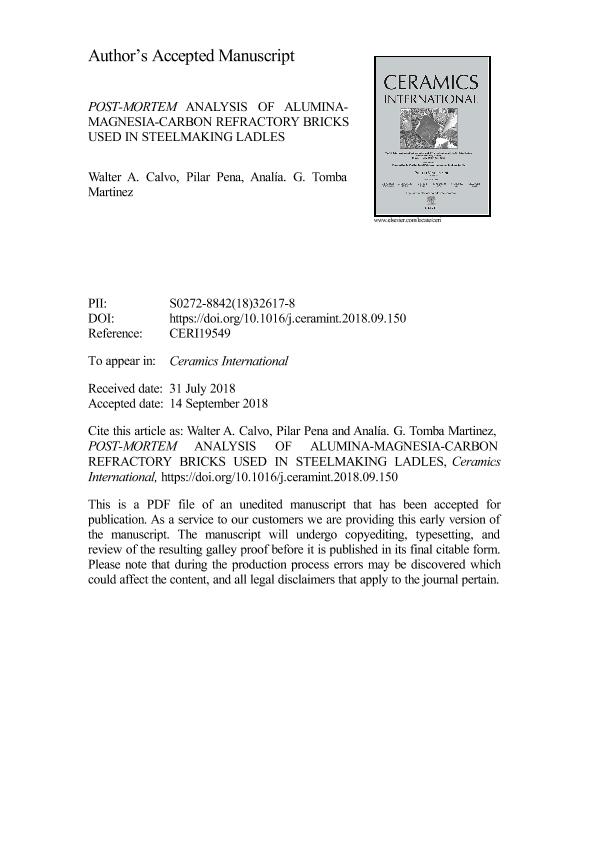Mostrar el registro sencillo del ítem
dc.contributor.author
Calvo, Walter Andrés

dc.contributor.author
Pena, Pilar
dc.contributor.author
Tomba Martinez, Analia Gladys

dc.date.available
2019-09-23T15:15:31Z
dc.date.issued
2019-01-15
dc.identifier.citation
Calvo, Walter Andrés; Pena, Pilar; Tomba Martinez, Analia Gladys; Post-mortem analysis of alumina-magnesia-carbon refractory bricks used in steelmaking ladles; Elsevier; Ceramics International; 45; 1; 15-1-2019; 185-196
dc.identifier.issn
0272-8842
dc.identifier.uri
http://hdl.handle.net/11336/84115
dc.description.abstract
Post-mortem studies in secondary steelmaking ladles are an important way to determine the factors related to Alumina-Magnesia-Carbon (AMC) refractory corrosion. AMC refractory bricks installed in the impact zone of a steelmaking ladle bottom were analyzed after 100 castings. X-ray diffraction, X-ray fluorescence chemical analysis, reflected optical light microscopy, scanning electron microscopy, energy dispersive X-ray spectrometry, density and porosity measurements, and mercury porosimetry were used to analyze the chemical and physical characteristics of the slag, the unused refractory and the slag+steel attacked bricks. The corrosion process produced a specific microstructure characterized by: i) a thick discontinuous slag layer composed by secondary spinel+steel+liquid; ii) a thick dense, cracked, and continuous layer consisting of calcium aluminates+steel+liquid at the slag/refractory interface; iii) next to this layer, a wide densified layer with a uniform microstructure in which corundum aggregates and spinel crystals were linked together by elongated CaAl12O19 crystals. The formation of these reaction layers constituted a barrier that effectively suppressed the massive slag penetration and surely reduced the wear rate. Thermodynamic calculations based on simplified and complex condensed phase equilibrium diagrams, were used to further understanding of the corrosion mechanism.
dc.format
application/pdf
dc.language.iso
eng
dc.publisher
Elsevier

dc.rights
info:eu-repo/semantics/openAccess
dc.rights.uri
https://creativecommons.org/licenses/by-nc-nd/2.5/ar/
dc.subject
C. Corrosion
dc.subject
E. Refractories
dc.subject
Post-Mortem Analysis
dc.subject.classification
Cerámicos

dc.subject.classification
Ingeniería de los Materiales

dc.subject.classification
INGENIERÍAS Y TECNOLOGÍAS

dc.title
Post-mortem analysis of alumina-magnesia-carbon refractory bricks used in steelmaking ladles
dc.type
info:eu-repo/semantics/article
dc.type
info:ar-repo/semantics/artículo
dc.type
info:eu-repo/semantics/publishedVersion
dc.date.updated
2019-08-01T19:58:43Z
dc.journal.volume
45
dc.journal.number
1
dc.journal.pagination
185-196
dc.journal.pais
Países Bajos

dc.journal.ciudad
Amsterdam
dc.description.fil
Fil: Calvo, Walter Andrés. Consejo Nacional de Investigaciones Científicas y Técnicas. Centro Científico Tecnológico Conicet - Mar del Plata. Instituto de Investigaciones en Ciencia y Tecnología de Materiales. Universidad Nacional de Mar del Plata. Facultad de Ingeniería. Instituto de Investigaciones en Ciencia y Tecnología de Materiales; Argentina
dc.description.fil
Fil: Pena, Pilar. Instituto de Ceramica y Vidrio de Madrid; España
dc.description.fil
Fil: Tomba Martinez, Analia Gladys. Consejo Nacional de Investigaciones Científicas y Técnicas. Centro Científico Tecnológico Conicet - Mar del Plata. Instituto de Investigaciones en Ciencia y Tecnología de Materiales. Universidad Nacional de Mar del Plata. Facultad de Ingeniería. Instituto de Investigaciones en Ciencia y Tecnología de Materiales; Argentina
dc.journal.title
Ceramics International

dc.relation.alternativeid
info:eu-repo/semantics/altIdentifier/doi/http://dx.doi.org/10.1016/j.ceramint.2018.09.150
dc.relation.alternativeid
info:eu-repo/semantics/altIdentifier/url/https://www.sciencedirect.com/science/article/pii/S0272884218326178
Archivos asociados
